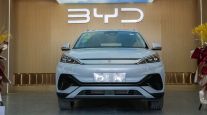Managing Editor, Features and Multimedia
Electric Trucks Advance
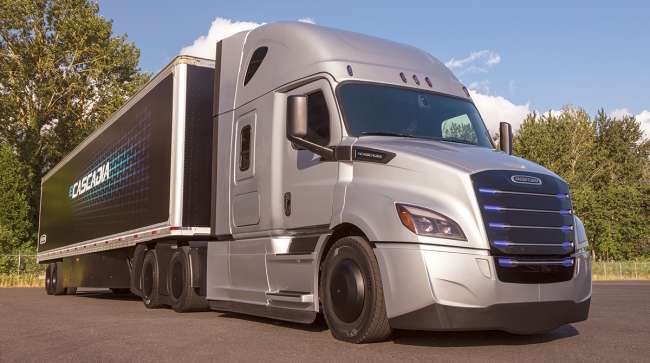
As electric vehicle technology becomes increasingly viable for commercial trucking, fleets and manufacturers are preparing to put the first generation of battery-electric trucks on the road.
Although diesel likely will remain trucking’s primary fuel for decades to come, particularly for longhaul operations, the introduction of these electric-powered trucks will represent the industry’s first steps toward a future beyond the internal combustion engine. It also will mark perhaps the biggest change in trucking equipment since the motor vehicle replaced the horse and carriage.
PLUGGING INTO AN ELECTRIC FUTURE: Preview our Dec. 19 LiveOnWeb program
In the near-term, electric trucks will be limited to specific applications that are well-suited to the technology, and many questions about their capabilities will remain unanswered until these vehicles log significant miles in real-world trucking operations.
But established industry leaders and new technology developers are taking on this electrification challenge.
All of the major global truck manufacturers and many of their key suppliers are investing in electric vehicle technology as they prepare to compete in this emerging segment of the truck market.
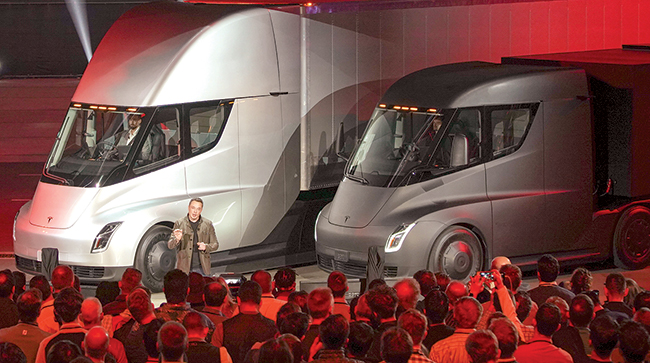
Tesla's Elon Musk speaks to the crowd in 2017 after the unveiling of the long-awaited, all-electric Class 8 tractor, the Tesla Semi. (Tesla)
Some already have begun to introduce their first medium- and heavy-duty battery-electric models, with series production set to begin within the next few years.
At the same time, startups and new players in the truck manufacturing business are looking to jump into the industry with electric-powered trucks of their own.
Despite the crowded field of electric-truck developers, Daimler Trucks North America CEO Roger Nielsen said the focus at this stage should not be on rushing to market or securing preorders, but on gaining knowledge and building customers’ confidence in this technology.
“I don’t want to get caught in some kind of race,” Nielsen said during a media roundtable in October. “What we’re trying to do is get the most experience that we can.”
DTNA recently hosted executives from 30 of its fleet customers to drive its first battery-electric models and discuss potential use cases for those vehicles, as well as key factors such as charging infrastructure, government financial incentives, route planning and maintenance.
I don’t want to get caught in some kind of race. What we’re trying to do is get the most experience [with electric vehicles] that we can.
Roger Nielsen, Daimler Trucks North America
Although electric vehicles represent a path to zero-emission trucking and huge fuel savings for fleets, applications will be limited at first, and several hurdles remain for adoption.
Early models are designed primarily for shorthaul applications such as urban pickup and delivery, refuse trucks and port drayage.
Opportunities for regional routes may be next, perhaps followed at some point by longhaul operations, but battery technology will need to continue to improve to reduce weight and extend vehicle range. The industry also will need to establish adequate charging infrastructure to support these vehicles.
Battery-electric trucks represent an entirely different vehicle architecture, one that no longer relies on an internal combustion engine or diesel emission-control systems. In theory, this could reduce vehicle downtime and maintenance costs, but the technology still is largely untested in the rigors of the commercial trucking environment.
At the same time, fleets will continue to evaluate other alternative fuels.
Some developers are investing in hydrogen fuel-cell technology as a way to extend the range of electric trucks.
Meanwhile, compressed natural gas remains the most widespread alternative to diesel available on the market today.
And diesel, of course, isn’t going away any time soon. The maturity of diesel technology and the flexibility afforded by its existing fueling infrastructure mean that diesel likely will remain the dominant fuel for longhaul trucking for many years, especially for irregular routes.
The First Generation of Electric Trucks
Early iterations of medium- and heavy-duty electric vehicles already are beginning to enter the commercial trucking industry, with market availability and series production just a few years away.
In June, DTNA unveiled battery-electric versions of its flagship heavy-duty Freightliner Cascadia and medium-duty M2 model. The truck maker said it plans to begin series production of the eCascadia and eM2 in 2021.
To help pave the way for those product launches, DTNA has partnered with two of its fleet customers — Penske Truck Leasing and NFI Industries — to place 30 of those vehicles in the field for testing in real-world operations.
Penske, which was set to receive 10 eCascadias and 10 eM2s, plans to put those vehicles in the hands of its lease customers, who will use them to deliver actual freight in local and regional applications.
Bill Combs, director of fleet connectivity at Penske Truck Leasing, said the company expects “nonstop learning from the minute we start running them.”
“There’s an expectation from our customers that we be ahead of a lot of these technologies,” he said.
While it’s hard to tell how quickly electric trucks will become successful, the emergence of these vehicles is “probably one of the biggest changes in trucking in decades,” Combs added.
The battery-electric Volvo FL in action. @VolvoTrucks pic.twitter.com/DIwhePS5yM — Seth Clevenger (@SethClevenger) June 20, 2018
Volvo Trucks, meanwhile, has announced that it will begin deploying all-electric trucks in California next year with plans to commercialize them in North America in 2020.
Volvo will introduce its demonstration trucks through a partnership with California’s South Coast Air Quality Management District, which has received a preliminary award of $44.8 million for the project from the California Air Resources Board.
Volvo Trucks President Claes Nilsson described the project as an important step toward the company’s vision of zero-emission trucking.
“We are convinced that electrified truck transport will be a key driver of sustainable transports, and we’re proud to contribute the Volvo Group’s expertise to this innovative public-private partnership,” he said.
Earlier this year, Volvo introduced two electric models for the European market that it intends to begin selling next year.
Meanwhile, Mack Trucks plans to supply a fully electric Mack LR refuse truck to the New York City Department of Sanitation for testing in 2019.
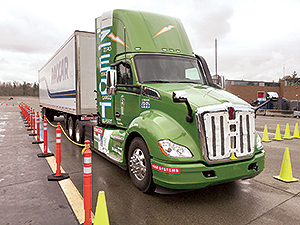
A ZECT — Zero-Emission Carbon Transport — Kenworth T680 day cab equipped with a hydrogen fuel cell at Kenworth's ride and drive event. (Roger Gilroy/Transport Topics)
Paccar Inc. also is testing electric vehicle technologies through its operating companies, Kenworth Truck Co. and Peterbilt Motors Co.
Kenworth has introduced electric-powered prototypes based on its T680 model. One of those trucks is equipped with hydrogen fuel-cell technology, while another uses a hybrid system that combines battery-electric propulsion with a CNG engine to extend the vehicle’s range.
Peterbilt has displayed an all-electric version of its Model 579 built through a collaboration with TransPower, a supplier of zero-emission truck systems.
Navistar Inc., which builds International brand trucks, has announced plans to introduce a medium-duty electric model as its first entry in this emerging segment.
That vehicle, an electric Class 6 or 7 box truck for pickup and delivery applications, will be based on the International MV Series and have a range of 100 to 120 miles, said Darren Gosbee, vice president of powertrain and advanced engineering.
Port drayage operations also have become “a significant area of interest” for Navistar’s electric truck development work, but that application will require a different battery pack and a range of 120 to 150 miles, Gosbee said. That truck would be based on the RH Series.
The battery technology, we believe, has to go through another revolution of development to be able to get to a point where the energy density of the battery is there [for longhaul].
Darren Gosbee, Navistar
Navistar plans to seed the market with some electric trucks by the end of 2019 and then roll out a larger number of vehicles to the marketplace by the end of 2020, Gosbee said.
However, the truck maker has not focused its efforts on developing a heavy-duty electric tractor for longhaul applications.
“The battery technology, we believe, has to go through another revolution of development to be able to get to a point where the energy density of the battery is there,” Gosbee said. “The coast-to-coast Class 8 sleeper, I think, is a long way from being electrified purely as a battery-electric vehicle.”
The industry’s established manufacturers and suppliers are not alone in the pursuit of commercial vehicle electrification.
New players in the truck-making business have showcased their own electric models and have helped spark a conversation about the potential for zero-emission trucking.
Startup truck manufacturer Nikola Motor Co. was the first out of the gate with the unveiling of its Class 8 hydrogen-electric Nikola One sleeper model in late 2016. The company later introduced a day cab version, the Nikola Two, and a cabover for the European market, the Nikola Tre. Nikola has said it plans to launch field tests of its hydrogen-electric trucks in 2019.
The electric-truck conversation gained additional energy in late 2017 when electric car maker Tesla Inc. trumpeted its entry into the commercial truck segment with the introduction of its battery-electric Tesla Semi. At the vehicle’s unveiling, co-founder and CEO Elon Musk said production was planned for 2019.
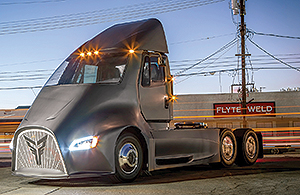
Thor intends to market in 2019 the ET-1, a battery-electric Class 8 day cab that will have a 100-mile range and cost $150,000. (Thor Trucks Inc.)
Thor Trucks, another startup, also plans to begin manufacturing battery-electric Class 8 trucks starting next year.
When electric trucks reach the market, their residual value will be an important consideration for fleets.
Nielsen said DTNA’s fleet customers don’t expect to change their trade cycles when they begin adding battery-electric trucks to their fleets.
Much like newer diesel models, customers should expect an improvement in energy efficiency year over year, and they will want to take advantage of those improvements rather than holding on to their existing vehicles, he said.
But it also will be important that the trucks maintain their value on the used market.
“Residual value and retention of the value through the life of the vehicle is at the top of the list,” Nielsen said.
A New Vehicle Architecture
In the early stages of the electric truck market, while sales volumes still are low, developers and suppliers will strike a balance between optimizing vehicle efficiency and utilizing existing components and designs that already have been developed, said Jason Roycht, vice president of Bosch’s commercial vehicle and off-road business unit in North America.
“It’s not about optimal efficiency just yet,” he said. “It’s about a balance of how much do I need to spend in development to get it to market, how much is my cost basis for it, and can I make a total cost of ownership argument for my vehicle. So you’ll see a lot of different approaches.”
For example, truck manufacturers generally are developing electric trucks that use the same chassis as their existing diesel models, rather than creating brand-new vehicles from the ground up.
Engineering costs also are guiding the design of electric powertrains.
The easiest approach is to simply add an electric motor to a traditional axle, Roycht said. “That’s not necessarily the most efficient approach to that problem, but it might be efficient enough for the application.”
Over time, as developers focus more on maximizing efficiency, electric vehicle designs will shift toward electric motors on wheels, he said.
Navistar’s Gosbee shared a similar perspective.
Because the initial market and sales volumes for electric trucks will be limited, the easiest approach will be to take an existing model and modify it with an electric propulsion system, he said.
“That is not truly optimized,” Gosbee said. “There is going to be a lot more opportunity for optimization as the volumes for e-mobility comes up. We will have a stronger business case to design and develop electric vehicles from the ground up.”
Diesel-Electric Hybrids
Unlike the passenger car market, most truck manufacturers generally have been moving directly to all-electric or hydrogen-electric vehicles rather than investing heavily in the intermediate step of diesel-electric hybrids.
Earlier this year, Martin Daum, head of Daimler’s global truck and bus division, said he is “not a big fan” of hybrids.
“To me, a hybrid gives you the worst of both worlds,” he said. “You still have to fulfill all the regulations on exhaust for any given diesel truck,” and then you add the challenges of introducing battery-electric technology.
To me, a hybrid gives you the worst of both worlds. You still have to fulfill all the regulations on exhaust for any given diesel truck.
Martin Daum, Daimler Trucks North America
Paccar business unit DAF Trucks, however, showcased a diesel-electric hybrid alongside two fully electric models this fall at the IAA Commercial Vehicles show in Hanover, Germany.
Others also see potential for hybrids in certain use cases.
Johannes-Joerg Rueger, president of Bosch’s global commercial vehicles business, said he sees hybrids as a viable option, particularly for vehicles that enter the inner city.
“For the last mile, being able to drive fully electric would certainly be a plus,” Rueger said in an interview at IAA. “It comes with a cost but would offer some additional options.”
Developing a Charging Network
For battery-electric vehicles to work in trucking, they will need adequate charging infrastructure.
Early electric trucks may simply recharge at their home terminals, but the potential for these vehicles to expand into longer routes will depend on a broader network of charging stations.
Daimler’s Daum described this infrastructure issue as a “chicken-and-egg problem.”
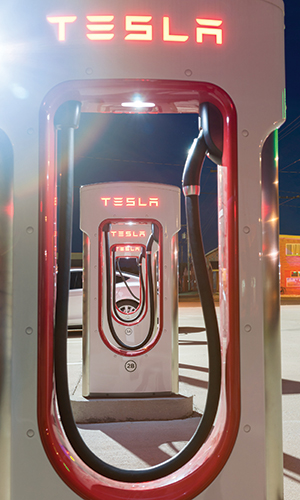
A Tesla battery recharge station in Shamrock, Texas. (Getty Images)
Higher vehicle volumes would support infrastructure investment, and broad availability of charging stations would support vehicle sales, but the question is which will come first.
“With electric, you still have to choose your routes very carefully,” Daum said. “Predictability is important.”
Work currently is underway to develop charging standards for heavy-duty electric vehicles.
A number of truck manufacturers, suppliers, energy companies and other players in the transportation industry have joined the Charging Interface Initiative, or CharIn, an association focused on establishing a worldwide standard for electric vehicle-charging infrastructure.
Meanwhile, fueling providers already are thinking about how to serve the nascent electric truck market.
Trillium CNG, best known for its more than 200 public and private CNG fueling stations, is moving toward a more diversified energy approach as its fleet customers begin to explore battery-electric and hydrogen fuel-cell vehicles.
“Each fuel will have its own strengths and weaknesses, or trade-offs, and all of our customers have their own unique goals,” said Bill Cashmareck, managing director of Trillium, which was acquired by Love’s Travel Stops & Country Stores in 2016.
Trillium is expanding into electrification through a partnership with EV Connect, an electric vehicle-charging firm, to establish light-duty charging sites at four Love’s locations in California.
The goal, Cashmareck said, is to gain more experience and data to ultimately introduce more light-duty EV chargers to the motoring public, then help “bridge the gap for Class 8, when it comes.”
Ultimately, plans for a heavy-duty charging network will be shaped by factors such as the range and battery capacity of the electric trucks that reach the market, he said.
Another variable that fleets and charging providers will need to consider is the cost of electricity and the potential for demand charges from power companies that could put the whole operation into the red.
Cashmareck suggested that large electric vehicle fleets could consider a different option: establishing a closed-loop charging system that doesn’t rely on the power grid.
He said Trillium is developing a vehicle charging system that would produce on-site power from generators, turbines and potentially solar energy, thus allowing customers to take power generation into their own hands and reduce or even eliminate utility charges.
That concept could work at a public truck stop or at a customer’s private lot, Cashmareck said. “We think we’re coming up with some innovative solutions for the EV market if fleets choose to go that way.”
Emission Regulations and Incentives
While trucking companies consider the potential business cases for adding electric trucks to their fleets, these vehicles also will help truck manufacturers meet tighter emission regulations in the coming decade.
By introducing zero-emission electric trucks to their product lineups, OEMs will gain a leg up on the Phase 2 greenhouse-gas emission and fuel economy standards issued in 2016 by the U.S. Environmental Protection Agency and the National Highway Traffic Safety Administration. Under that rule, new medium- and heavy-duty vehicles and engines will need to comply with increasingly strict carbon dioxide emission limits in 2021, 2024 and 2027.
By selling even small volumes of zero-emission electric trucks, OEMs can bring down their corporate fuel-economy average while banking credits for exceeding emission standards.
“There’s a lot of incentive to overcomply,” said Glen Kedzie, energy and environmental counsel at American Trucking Associations. “When the milestones are more stringent in the future, if you are having a more difficult time hitting the targets, you can dip into your credit piggy bank.”
He added, “They’re going up a mountain, and the mountain gets steeper the higher they go.”
Navistar’s Gosbee also cited the compliance benefits of electric trucks as greenhouse gas standards tighten in the years ahead.
By adding electric vehicles to their product lineups, OEMs will have more flexibility to sell other trucks with features that aren’t as greenhouse gas-friendly, he said.
Beyond regulatory compliance, fleets also can take advantage of financial incentives to purchase electric trucks, particularly in California and at major seaports such as the ports of Los Angeles and Long Beach.
Telematics in the Electric Fleet
The introduction of electric trucks also will mark a new frontier for commercial vehicle telematics.
New metrics such as battery state of charge and battery health will become important data sets for managers of electric truck fleets.
Trucking telematics vendor Geotab has taken steps to prepare for that future through its recent acquisition of FleetCarma, a technology supplier for electric fleets.
“We strongly believe that electric vehicles are the future,” said Scott Sutarik, Geotab’s associate vice president for commercial vehicle solutions.
He described the FleetCarma acquisition as “an excellent opportunity for Geotab to really supercharge our efforts in the electric space.”
FleetCarma has focused mostly on light-duty electric vehicles, but is preparing to serve the emerging medium- and heavy-duty electric truck market as well.
Matt Stevens, FleetCarma’s CEO, said many elements of onboard technology for electric trucks will carry over from diesel models, such as electronic logging of drivers’ hours of service.
But managing battery-charge levels and coordinating vehicle recharging will add a new layer of complexity for logistics planners.
“There is an intense requirement to become an energy manager, which is completely new,” Stevens said. “It’s not how you ever had to think about liquid fuel management. The economics can truly be phenomenal if you do it right, but it is a very different skill set that requires very different tools.”
Telematics will become an integral part of the “fueling” experience, he said, because the data will enable fleet managers to determine whether an electric truck can make another delivery based on its state of charge, and to monitor if and to what degree the battery’s capacity is degrading over time.
FleetCarma also provides a managed charging service designed to guarantee every vehicle is charged by the start of its shift, while synchronizing charging times in a way that reduces peak demand. That “smart charging” approach can dramatically cut electricity costs, which Stevens said can make the difference between being competitive and being out of business.
Telematics also can support fleets’ electric-vehicle purchase decisions through suitability assessments, Stevens added. By analyzing data from a company’s existing diesel fleet, FleetCarma can offer recommendations on the best ways to deploy electric trucks within those operations.
A Menu of Fuel Choices
Bosch’s Rueger predicted that commercial transportation in inner cities “will more or less become electric over time,” but the added weight of the batteries will make electric trucks impractical for longhaul.
However, Bosch does see potential for hydrogen fuel cell-powered trucks in longhaul applications.
“I believe it’s a very interesting option,” Rueger said.
Bosch is supplying its eAxle electric drive system to Nikola, which is developing not only hydrogen-electric trucks but also a hydrogen fueling network to support the vehicles.
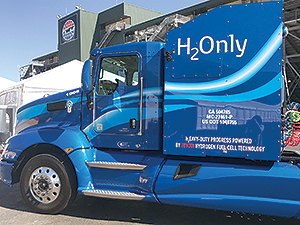
Toyota's hydrogen-powered Class 8 tractor developed for its operations at the Port of Long Beach, Calif. (Mindy Long for Transport Topics)
Rueger said these hydrogen-electric trucks have the potential to capture part of the North American market, but other routes would need to be served by other technologies.
“That’s why we believe that eventually fuel cells will be part of the equation, one of the solutions, but not the only one,” he said.
Any future technology, including electric trucks and fuel cells, will need to prove itself and compete with what is in the market now.
“Diesels have a long history and have proven maturity for longhaul,” Rueger said. “For the whole logistics segment, reliability is the most important factor. In our logistics chains today, we are so tight that it needs to work.”
As fleets begin testing the first wave of electric trucks in their freight operations, the industry soon will learn more about the strengths and weaknesses of these vehicles.
The results of those early deployments will provide a clearer picture of where and when this technology will be ready to transport its share of the world’s freight.







